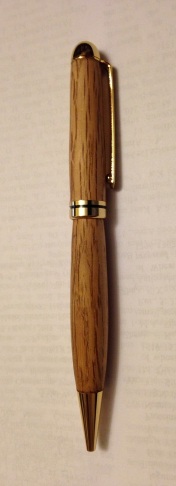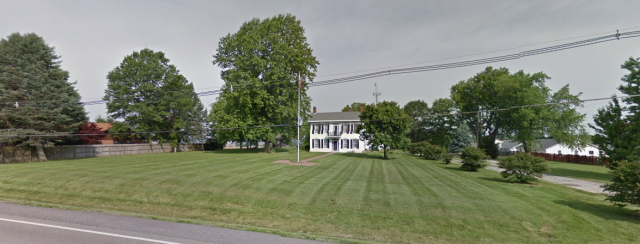For Christmas one of my brothers gave me a pen. A nice pen, with a wooden barrel. The cool part… well better than cool actually… the wood came from the old barn.

Not just any wooden pen.
Growing up on a farm used to be such an ordinary thing in the middle of the US. And growing up on a farm that had been a farm for quite a while… still fairly ordinary. This is not Europe, so the context of “quite a while” should be interpreted as somewhere between 1 and 2 hundred years.
So this farm my sibs and I grew up on – it was purchased by my parents right after I started school. It was at the time on the edge of Shiloh, a quiet little village which has since morphed into something quite different. The farm sat upon a ridge and commanded a view to the west that included the city of St. Louis on the distant horizon. In the mid 60s they built the Gateway Arch on the Mississippi shoreline by downtown St. Louis and we could watch them build it with a fair pair of binoculars from this very farm.
There was an old barn on the place. We used it to store hay, to house Holstein steers, the occasional pig, and a few chickens. Playing in the hay loft, doing chores, putting up hay, and razzing your siblings – all great memories played out on the stage that barn provided us.

Drawing from the 1874 St. Clair County Atlas.
They say time and tide wait for no man. I suppose ‘barn’ might be appropriately appended to the notion. There finally came a time in the growth and development of Shiloh when the farm was surrounded and the property value vastly exceeded the land’s capacity to remain a farm – or to need the services of an old barn. It was torn down.
My family kept pieces for the memories, and from one such piece of barn wood this pen was made.
The barn appeared in the 1874 St. Clair County Atlas. The drawing is fairly accurate for the buildings that remained by the middle of the 20th century when I came to know it. The stable between the house and barn was already missing by the time it became our home – but Dad did hit a huge white stone while plowing in the field where this drawing places the stable. We imagine it was a cornerstone for the stable.
The highest point in St Clair county is just off to the artist’s left, about 20 meters across Lebanon Avenue (the road in front of the property). The city of St Louis was already the economic hub of the region, and from this artist’s perpsective it lay off about 23 miles through a sight created by the lightning rods atop the house.
The Engelmann homestead, one of the oldest farms in the area, was less than a few hundred yards immediately behind the point from which the artist captured this scene. We used to bale straw on a field just south of the Engelmann’s place. I did some research on the Englemanns when I was in high school. They were German immigrants. One of the Engelmann daughters was married to Gustav Koerner, himself a German immigrant who went on to be the 12th Lt Governor of Illinois and a politcal friend of Abraham Lincoln.
Obviously the wood from the barn came from a tree. And it’s the tree that became a part of this barn and has now come to me as part of this pen that I find somewhat interesting. That tree was likely still growing during the Civil War. If the tree were even close to a hundred years of age it would have been around at the time of the Revolution as well. If it could speak, the stories it might tell.

The farmhouse as it appeared in June 2013 – from a Google street view shot.

Clem,
Well done, sir. An exceptionally evocative portrait of your family farm. Glad to see the old print of the actual farm. What a relic to have discovered. I always love to see the stocking ratios in these prints, how do they do it! Do you have a copy of the print framed?
And what a nice gift that you can hand down to a grandson someday.
Thanks for sharing the memory,
Brian
LikeLiked by 1 person
On the stocking rate… I have to believe the artist took some liberties (or artistic license?). The architectural detail of the buildings I knew is very accurate, but the buildings weren’t moving 🙂 . Also one has to wonder about the placing of the critters – their relatively even spread upon the landscape where herding animals tend to flock (sheep especially). We were also struck by what may be some sort of goat but we thought might be reindeer in the front most paddock.
Some landscape details are also a bit suspect. There was a pond approximately where one is shown on the drawing, but it was at least another time larger than the one pictured. I’m less concerned about such because the landscape can be modified over time and there are about one hundred years between the drawing and my observation of the scene.
My Mother discovered the print after we’d been approached several times about the history of the house and she decided to do some research. She does have a framed copy. The St. Clair Historical Society recognized the farmhouse while I was still at home and there is a little bronze placard by the front door to acknowledge this.
There are a handful of other houses in the area that date from the same period and still exist. Unfortunately the Engelmann homestead house does not (and has been gone a long time – I never got to see it). There is only one of these farmsteads in the area that I know of which might still have one of the old wooden barns (brick does appear to last longer). I should ask my brother if he’s seen it recently.
The Gustav Koerner house in Belleville (as a lawyer the man couldn’t be bothered to farm 😦 ) has been preserved and turned into a museum. Until doing some background for this piece I didn’t realize Gustav had married into the Engelmann family. There is, for me at least, some interesting history concerning GK and I may come back to it at some time.
I’d been meaning to write about the farm for a while – to set a record of place so that future stories about life experiences would have a setting to live within. A Port Royal if you will. The gift of the pen pushed me to finally make it happen.
LikeLike
[…] area with my father and once their brood grew too large for their little village house we moved out to the farm. Learning to live on a farm with a houseful of children was for her an education in real […]
LikeLike
[…] years ago I wrote a piece for this blog about the old barn that used to stand on that farm. As it happens, there were Holstein steers fed in that barn while […]
LikeLike